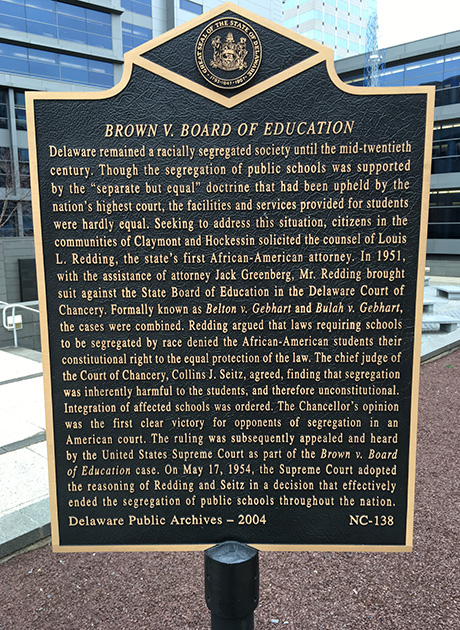

 Delaware remained a racially segregated society until the mid-twentieth century. Though the segregation of public schools was supported by the “separate but equal” doctrine that had been upheld by the nation’s highest court, the facilities and services provided for students were hardly equal. Seeking to address this situation, citizens in the communities of Claymont and Hockessin solicited the counsel of Louis L. Redding, the state’s first African-American attorney. In 1951, with the assistance of attorney Jack Greenberg, Mr. Redding brought suit against the State Board of Education in the Delaware Court of Chancery. Formally known as Belton v. Gebhart and Bulah v. Gebhart, the cases were combined. Redding argued that laws requiring schools to be segregated by race denied the African-American students their constitutional right to the equal protection of the law. The chief judge of the Court of Chancery, Collins J. Seitz, agreed, finding that segregation was inherently harmful to the students, and therefore unconstitutional. The Chancellor’s opinion was the first clear victory for opponents of segregation in an American court. The ruling was subsequently appealed and heard by the United States Supreme Court as part of the Brown v. Board of Education case. On May 17, 1954, the Supreme Court adopted the reasoning of Redding and Seitz in a decision that effectively ended the segregation of public schools throughout the nation.
Delaware remained a racially segregated society until the mid-twentieth century. Though the segregation of public schools was supported by the “separate but equal” doctrine that had been upheld by the nation’s highest court, the facilities and services provided for students were hardly equal. Seeking to address this situation, citizens in the communities of Claymont and Hockessin solicited the counsel of Louis L. Redding, the state’s first African-American attorney. In 1951, with the assistance of attorney Jack Greenberg, Mr. Redding brought suit against the State Board of Education in the Delaware Court of Chancery. Formally known as Belton v. Gebhart and Bulah v. Gebhart, the cases were combined. Redding argued that laws requiring schools to be segregated by race denied the African-American students their constitutional right to the equal protection of the law. The chief judge of the Court of Chancery, Collins J. Seitz, agreed, finding that segregation was inherently harmful to the students, and therefore unconstitutional. The Chancellor’s opinion was the first clear victory for opponents of segregation in an American court. The ruling was subsequently appealed and heard by the United States Supreme Court as part of the Brown v. Board of Education case. On May 17, 1954, the Supreme Court adopted the reasoning of Redding and Seitz in a decision that effectively ended the segregation of public schools throughout the nation.
NC-138: Originally installed in 2004.
500 N. King St. Wilmington, DE 19801
Related Topics: African American, Belton v. Gebhart, Brown v. Board of Education, Bulah v. Gebhart, Collins J. Seitz, Delaware Court of Chancery, Desegregation, Jack Greenberg, Louis L. Redding, Segregation, State Board of Education